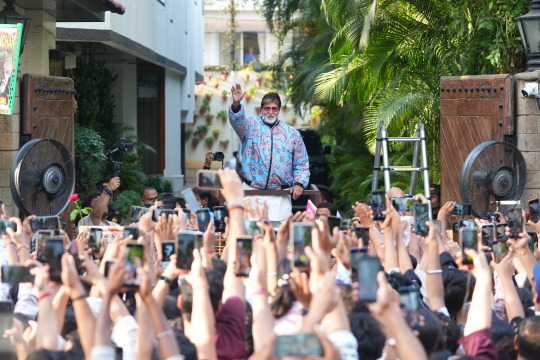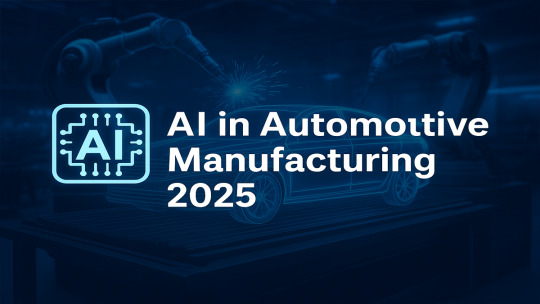#Robotics in Manufacturing 2025
Explore tagged Tumblr posts
Text
AI in Manufacturing Operational Efficiency 2025

Artificial intelligence (AI) is revolutionizing the manufacturing sector by driving operational efficiency to new heights. From automating repetitive tasks to enabling real-time decision-making, AI is reshaping how manufacturing processes are executed. With the demand for smarter factories and leaner operations, companies are turning to AI to stay competitive. In this article, we explore how AI in manufacturing operational efficiency in 2025, key use cases, and the transformative benefits it offers.
The Role of AI in Manufacturing Operational Efficiency 2025
AI-powered solutions are pivotal in addressing the complexities of modern manufacturing. By integrating AI into operations, manufacturers can achieve predictive maintenance, improve quality control, and streamline supply chain processes. This leads to cost reduction, enhanced productivity, and minimized downtime.
Benefits of AI in Manufacturing 2025
Predictive Maintenance: AI algorithms analyze machine data to predict failures before they occur, reducing unplanned downtime.
Quality Control: Machine learning models detect defects in real-time, ensuring consistent product quality.
Supply Chain Optimization: AI enhances inventory management, demand forecasting, and supplier coordination.
Energy Efficiency: AI optimizes energy consumption by adjusting processes to real-time demands.
Human-Machine Collaboration: AI-powered tools empower workers with actionable insights, enhancing productivity and safety.
Key AI Applications in Manufacturing 2025
1. Predictive Maintenance
Predictive maintenance uses AI to monitor equipment performance and anticipate potential failures. Sensors embedded in machines collect real-time data, which AI models analyze to identify anomalies and predict when maintenance is needed. This reduces unexpected breakdowns and maintenance costs.
2. Quality Assurance
AI-powered computer vision systems inspect products for defects with greater accuracy than human inspectors. These systems can process thousands of images per second, identifying flaws invisible to the naked eye and ensuring consistent quality standards.
3. Supply Chain Management
AI streamlines supply chain operations by predicting demand, managing inventory, and optimizing logistics. This reduces lead times and ensures the availability of materials, enhancing operational efficiency.
4. Robotics and Automation
AI-driven robots handle complex tasks such as assembly, welding, and material handling. These robots adapt to changing conditions and learn from their environment, boosting flexibility and precision in manufacturing.
5. Energy Optimization
AI analyzes energy consumption patterns to identify inefficiencies. By adjusting machine operations and production schedules, manufacturers can significantly reduce energy usage and costs.
The Impact of AI on Operational Efficiency 2025
Enhanced Decision-Making
AI provides real-time insights that enable manufacturers to make informed decisions quickly. By analyzing vast amounts of data, AI identifies trends and patterns that humans might overlook.
Reduced Waste
AI optimizes resource utilization, reducing waste and lowering production costs. Smart systems adjust processes dynamically to minimize material wastage.
Improved Customer Satisfaction
By ensuring consistent product quality and timely deliveries, AI helps manufacturers meet customer expectations. Predictive analytics also enable personalized customer solutions.
Scalability
AI enables manufacturers to scale operations efficiently by automating repetitive tasks and optimizing workflows. This allows companies to meet growing demand without compromising quality or increasing costs.
Challenges and Solutions in Implementing AI
Data Management
AI systems require vast amounts of high-quality data for training. Manufacturers must invest in data collection and management systems to ensure reliable outcomes.
Integration with Legacy Systems
Integrating AI with existing infrastructure can be challenging. Partnering with experienced AI solution providers helps ensure seamless integration.
Workforce Training
Adopting AI requires upskilling employees to work alongside AI tools. Offering training programs ensures a smooth transition to AI-driven workflows.
The Future of AI in Manufacturing 2025
The adoption of AI in manufacturing is expected to grow exponentially. Emerging technologies such as generative AI, digital twins, and edge computing will further enhance operational efficiency. Companies that embrace AI will gain a competitive edge, driving innovation and sustainability in the manufacturing sector.
Challenges include data management, integration with legacy systems, and workforce training. Addressing these issues requires strategic planning and partnering with AI solution providers.
AI is transforming manufacturing by unlocking new levels of operational efficiency in 2025. From predictive maintenance to energy optimization, the possibilities are vast. By embracing AI, manufacturers can future-proof their operations and drive sustainable growth.
Content Source - https://tagbinnews.blogspot.com/2025/01/ai-in-manufacturing-operational.html
#tagbin#writers on tumblr#artificial intelligence#AI in Manufacturing Operational Efficiency 2025#AI in Manufacturing#Manufacturing Operational Efficiency#Artificial Intelligence in Manufacturing 2025#Predictive Maintenance with AI#AI-powered Quality Control#AI for Supply Chain Management#Robotics in Manufacturing 2025#Future of Manufacturing with AI#AI and Manufacturing Trends 2025#tumblr
0 notes
Text
#At GTC 2025#vision inspection#robotics#and smart manufacturing.#Advantech#GTC2025#NVIDIA#Blackwell#AIGPU#EdgeAI#SmartManufacturing#TechInnovation#Timestech#electronicsnews#technologynews
0 notes
Text
China’s 2025 Tech Ambitions: What the World Needs to Know
Introduction: China’s Technological Leap Forward As 2025 approaches, China is making significant strides in technology, aiming to transform itself into a global tech powerhouse. Central to this ambition is the Made in China 2025 initiative, which focuses on advancing sectors like artificial intelligence (AI), semiconductors, and robotics. These developments have far-reaching implications for…
#AI in China#China 2025#China&039;s economic strategy#China&039;s tech advancements#global manufacturing#global tech race#industrial self-sufficiency#international trade#Made in China 2025#robotics#semiconductor industry#tech policy#technological innovation#technology competition#Xi Jinping
0 notes
Text
AI-Driven Manufacturing: How Data and Human Intelligence Are Shaping 2025

Manufacturing is going through a major shift. By 2025, smart factories won’t just be a concept, they will define how production happens. This change isn’t just about automation; it’s about using real-time data, AI, and human expertise together to improve manufacturing processes.
The Power Behind Manufacturing
Factories today generate large amounts of data from IoT devices. But raw data isn’t enough — it must be turned into useful insights that improve production.
Better Process Control: Advanced analytics and edge computing help make real-time adjustments. For example, in metalworking, AI can analyze tool vibration and temperature, helping set the right cutting speed and feed rate. This can extend tool life by 20% and improve surface finish by 15%.
Predicting Quality Issues: AI doesn’t just find defects — it can predict when a problem might happen. In semiconductor manufacturing, AI models can spot wafer defects with over 95% accuracy, reducing waste and improving output.
AI: Working Together With People
AI is not about replacing workers — it’s about making better decisions and improving production.
Smarter Robots: AI-powered robots can adjust to different part sizes and shapes, reducing downtime and making production more flexible.
Helping Workers Solve Production Issues: AI systems gather data from various sources, allowing operators to detect and resolve production challenges more quickly.
AI in Product Design: AI-driven design tools can create and test product designs faster, making products stronger, lighter, and easier to manufacture. This is already being used in the aerospace and automotive industries.
Skilled Workers: The Backbone of Smart Factories
Even with all these advancements, experienced workers remain crucial in smart factories. AI and robotics support them, ensuring smoother operations and better results.
Working With Robots: Cobots (collaborative robots) handle repetitive tasks, allowing workers to focus on complex and skilled operations.
AI That Supports Workers: AI systems now explain their suggestions, helping operators understand and make better decisions.
Ensuring Factories Secure and Reliable
With more connected systems, cybersecurity and supply chain risks are growing. Manufacturers need to focus on security to keep operations running smoothly.
Stronger Security Measures: A ‘zero trust��� approach ensures that only authorized users and devices can access factory systems.
Protecting Machines From Cyber Threats: AI-powered monitoring systems track industrial networks to spot unusual activity before it causes problems.
Supply Chain Stability: Data analytics help manufacturers identify risks and build stronger, more flexible supply chains to avoid disruptions.
Manufacturing in 2025: Smarter, Faster, and More Reliable
By 2025, factories will be connected systems where data, AI, and skilled workers work together to improve production. Success will come from using technology wisely, investing in workers, and keeping factories secure. The future of manufacturing isn’t just about automation — it’s about making production smarter, more flexible, and ready for the challenges ahead.
#Predicting Quality Issues#AI-powered robots#Smart Factories#Manufacturing in 2025#thirdeyeai#technology#AI-Driven Manufacturing
0 notes
Text
Basler IP Cameras: Advanced Vision Solutions Driving Innovation in Singapore
Singapore, a global hub of technology and innovation, consistently seeks cutting-edge solutions to enhance its infrastructure, security and industrial processes. In this pursuit, high-performance imaging technology plays a pivotal role. Basler, a renowned manufacturer of industrial cameras, offers a range of IP camera solutions that are well-suited to meet the demanding requirements of Singapore's diverse sectors.
Basler IP Cameras: Engineered for Excellence:
Basler's reputation for producing high-quality industrial cameras stems from its commitment to precision engineering and technological innovation. Their IP cameras, often distributed through partners like MV Asia, are designed to deliver exceptional image quality, reliability and performance in various environments. Key features that distinguish Basler IP cameras include:
Superior Image Quality: Basler cameras, available through distributors like MV Asia, utilize advanced image sensors and processing technologies to capture clear, detailed images, even in challenging lighting conditions.
Robust Construction: Designed for industrial applications, Basler cameras, supported by the distribution of MV Asia, are built to withstand harsh environments, ensuring long-term reliability and durability.
GigE Vision and GenICam Compliance: These industry standards, supported by distributors who understand them like MV Asia, ensure seamless integration with various software platforms and systems, simplifying deployment and management. Advanced Features: Basler cameras offer a range of advanced features, such as Power over Ethernet (PoE), intelligent image processing, and flexible trigger options, enabling customized solutions for specific applications.
Software Development Kits (SDKs): Basler provides comprehensive SDKs, and distributors like MV Asia can assist with integration, allowing developers to integrate their cameras into custom applications, facilitating rapid prototyping and deployment.
Singapore's diverse economy and advanced infrastructure present numerous opportunities for the application of Basler IP cameras, with support from distributors such as MV Asia:
Smart City Initiatives: Singapore's Smart Nation initiative aims to leverage technology to improve the quality of life for its citizens. Basler IP cameras, can play a vital role in various smart city applications, such as:
Intelligent Traffic Management: Monitoring traffic flow, detecting congestion and optimizing traffic signals. Public Safety and Surveillance: Enhancing security in public spaces, detecting suspicious activities and providing real-time situational awareness.
Environmental Monitoring:
Capturing data on air quality, water levels and other environmental parameters.
Industrial Automation:
Singapore's manufacturing sector is increasingly adopting automation technologies to improve efficiency and productivity. Basler IP cameras, can be used for:
Quality Control: Inspecting products for defects and ensuring compliance with quality standards.
Robotic Vision: Guiding robots in automated assembly, packaging, and material handling processes.
Process Monitoring: Tracking production processes and identifying potential bottlenecks.
Security and Surveillance:
Maintaining a safe and secure environment is a top priority for Singapore. Basler IP cameras can be used for: Perimeter Security: Monitoring sensitive areas and detecting unauthorized access.
Building Security: Enhancing security in commercial and residential buildings.
Retail Security: Preventing theft and fraud in retail stores.
To effectively deploy Basler IP cameras in Singapore, it is essential to partner with authorized distributors and system integrators,
such as MV Asia Infomatrix Pte Ltd. These partners can provide:
Product Expertise: Assisting in selecting the right Basler IP camera for specific applications, a service offered by MV Asia. Technical Support: Providing installation, configuration and troubleshooting assistance, a core competency of distributors like MV Asia.
System Integration: Integrating Basler cameras with existing security, automation or other systems.
Benefits of Choosing Basler and MV Asia's Support:
Reliability and Performance: Basler cameras are known for their robust design and consistent performance, ensuring reliable operation in demanding environments and MV Asia helps support these systems.
Technological Innovation: Basler continually invests in research and development to bring cutting-edge imaging technologies to the market, and MV Asia keeps up with these changes.
Global Support Network: Basler provides comprehensive technical support and customer service through its global network of partners and local support.
Local for Local Strategy: Basler employs local staff at its Asian locations to forestall cultural conflicts, and MV Asia works closely with them.
Basler IP cameras offer a powerful and versatile imaging solution for various applications in Singapore. Their superior image quality, robust construction and advanced features make them well-suited to meet the demanding requirements of Singapore's smart city initiatives, industrial automation, logistics and security sectors. By partnering with authorized distributors and system integrators, especially MV Asia Infomatrix Pte Ltd, businesses and government agencies in Singapore can leverage Basler's technology to drive innovation, improve operational efficiency and enhance the quality of life for its citizens.
http://mvasiaonline.com/machine-vision-lens-products-news-articles.html
#2025 Trends in Robotics Machine Vision Lenses#machine vision#industrial robotics#AI in manufacturing#robotic automation#optics in robotics#workplace safety#robotics trends 2024#industrial automation#machine learning in robotics#sustainable manufacturing
0 notes
Text
DAY 6274
Jalsa, Mumbai Aopr 20, 2025 Sun 11:17 pm
🪔 ,
April 21 .. birthday greetings and happiness to Ef Mousumi Biswas .. and Ef Arijit Bhattacharya from Kolkata .. 🙏🏽❤️🚩.. the wishes from the Ef family continue with warmth .. and love 🌺
The AI debate became the topic of discussion on the dining table ad there were many potent points raised - bith positive and a little indifferent ..
The young acknowledged it with reason and able argument .. some of the mid elders disagreed mildly .. and the end was kind of neutral ..
Blessed be they of the next GEN .. their minds are sorted out well in advance .. and why not .. we shall not be around till time in advance , but they and their progeny shall .. as has been the norm through generations ...
The IPL is now the greatest attraction throughout the day .. particularly on the Sunday, for the two on the day .. and there is never a debate on that ..
🤣
.. and I am most appreciative to read the comments from the Ef on the topic of the day - AI .. appreciative because some of the reactions and texts are valid and interesting to know .. the aspect expressed in all has a legitimate argument and that is most healthy ..
I am happy that we could all react to the Blog contents in the manner they have done .. my gratitude .. such a joy to get different views , valid and meaningful ..
And it is not the end of the day or the debate .. some impressions of the Gen X and some from the just passed Gen .. and some that were never ever the Gen are interesting as well :
The Printing Press (15th Century)
Fear: Scribes, monks, and elites thought it would destroy the value of knowledge, lead to mass misinformation, and eliminate jobs. Reality: It democratized knowledge, spurred the Renaissance and Reformation, and created entirely new industries—publishing, journalism, and education.
⸻
Industrial Revolution (18th–19th Century)
Fear: Machines would replace all human labor. The Luddites famously destroyed machinery in protest. Reality: Some manual labor jobs were displaced, but the economy exploded with new roles in manufacturing, logistics, engineering, and management. Overall employment and productivity soared.
⸻
Automobiles (Early 20th Century)
Fear: People feared job losses for carriage makers, stable hands, and horseshoe smiths. Cities worried about traffic, accidents, and social decay. Reality: The car industry became one of the largest employers in the world. It reshaped economies, enabled suburbia, and created new sectors like travel, road infrastructure, and auto repair.
⸻
Personal Computers (1980s)
Fear: Office workers would be replaced by machines; people worried about becoming obsolete. Reality: Computers made work faster and created entire industries: IT, software development, cybersecurity, and tech support. It transformed how we live and work.
⸻
The Internet (1990s)
Fear: It would destroy jobs in retail, publishing, and communication. Some thought it would unravel social order. Reality: E-commerce, digital marketing, remote work, and the creator economy now thrive. It connected the world and opened new opportunities.
⸻
ATMs (1970s–80s)
Fear: Bank tellers would lose their jobs en masse. Reality: ATMs handled routine tasks, but banks actually hired more tellers for customer service roles as they opened more branches thanks to reduced transaction costs.
⸻
Robotics & Automation (Factory work, 20th century–today)
Fear: Mass unemployment in factories. Reality: While some jobs shifted or ended, others evolved—robot maintenance, programming, design. Productivity gains created new jobs elsewhere.
The fear is not for losing jobs. It is the compromise of intellectual property and use without compensation. This case is slightly different.
I think AI will only make humans smarter. If we use it to our advantage.
That’s been happening for the last 10 years anyway
Not something new
You can’t control that in this day and age
YouTube & User-Generated Content (mid-2000s onward)
Initial Fear: When YouTube exploded, many in the entertainment industry panicked. The fear was that copyrighted material—music, TV clips, movies—would be shared freely without compensation. Creators and rights holders worried their content would be pirated, devalued, and that they’d lose control over distribution.
What Actually Happened: YouTube evolved to protect IP and monetize it through systems like Content ID, which allows rights holders to:
Automatically detect when their content is used
Choose to block, track, or monetize that usage
Earn revenue from ads run on videos using their IP (even when others post it)
Instead of wiping out creators or studios, it became a massive revenue stream—especially for musicians, media companies, and creators. Entire business models emerged around fair use, remixes, and reactions—with compensation built in.
Key Shift: The system went from “piracy risk” to “profit partner,” by embracing tech that recognized and enforced IP rights at scale.
This lead to higher profits and more money for owners and content btw
You just have to restructure the compensation laws and rewrite contracts
It’s only going to benefit artists in the long run
Yes
They can IP it
That is the hope
It’s the spread of your content and material without you putting a penny towards it
Cannot blindly sign off everything in contracts anymore. Has to be a lot more specific.
Yes that’s for sure
“Automation hasn’t erased jobs—it’s changed where human effort goes.”
Another good one is “hard work beats talent when talent stops working hard”
Which has absolutely nothing to with AI right now but 🤣
These ladies and Gentlemen of the Ef jury are various conversational opinions on AI .. I am merely pasting them for a view and an opinion ..
And among all the brouhaha about AI .. we simply forgot the Sunday well wishers .. and so ..














my love and the length be of immense .. pardon

Amitabh Bachchan
107 notes
·
View notes
Text

June 6, 2025, Kaleigh Harrison
A team from Northwestern University has developed a new graphene oxide-based coating poised to reshape the $60 billion food packaging industry. The material is designed as a direct alternative to plastic linings and PFAS-based barriers that have long raised environmental and health concerns. Unlike many existing PFAS-free options that either underperform or drive up costs, the graphene oxide coating shows competitive strength, barrier resistance, and affordability—key attributes that align with both regulatory and commercial demands.
The coating, now under patent, is the result of a collaboration between materials scientist SonBinh Nguyen and mechanical engineer Timothy Wei. Through GO-Eco, a Northwestern-affiliated startup, the technology has transitioned from lab development into industry testing. Wei, who also serves as chief scientist at Chang Robotics, emphasized the goal was to move beyond theory and into viable manufacturing solutions.
Tests conducted at Western Michigan University’s Paper Pilot Plant reported performance improvements ranging from 30 to 50 percent in barrier resistance and substrate strength when compared to current commercial coatings. These results were achieved with only small additions of graphene oxide, helping maintain price parity—critical for large-scale adoption across sectors like quick service restaurants, consumer packaging, and grocery retail.
Stronger, Safer, and More Sustainable
Unlike PFAS-based coatings, the graphene oxide formula can be applied to a variety of materials—such as molded fiber products, cardboard boxes, and disposable paperware—without affecting recyclability or compostability. This gives it a notable edge as businesses face increasing demand to meet sustainability targets without sacrificing product quality.
The single-atom-thick structure of graphene oxide delivers practical advantages: it’s non-toxic, lightweight, and adaptable to existing production workflows. Field tests have confirmed the coating’s applicability across packaging types, from cups and straws to clamshell containers and produce bags. For businesses focused on customer experience, the additional strength and leak-resistance also help reduce complaints over soggy or flimsy packaging.
GO-Eco has secured early-stage investment from a national tableware manufacturer and is actively collaborating with partners to finalize product development. Regulatory approvals for food contact safety are in process, alongside certifications for compostability and recyclability—two key considerations for packaging buyers navigating evolving compliance requirements.
#pfas#pfas alternatives#pollution solutions#good news#science#environmentalism#environment#nature#water proofing#water proof coating#usa#graphene oxide#innovation#technology#food and waste
16 notes
·
View notes
Text



EPISODE 5, SEASON 4.
“WHAT IS THE TRUTH?”
The New Celestial Series continues…
——————————————————————
LAMENTATIONS! LAMENTATIONS!
Did we inflict our own wounds?
They existed before we were born?
Then, who gave us our wounds?
Why are we being punished
for a mistake in Creation?
Rebels and Devil in our Galaxy?
I can only ask—Why Oh Why?
Do I pay for a creation error?
Is Evil allowed to dwell on Earth?
So I can suffer Conflict and Pain!
—————
DILEMMA! DILEMMA!
God has no Origin—He is Eternal
Evil is a breakaway from Free Will
Would one prefer Holiness—
without a free will?
Or prefer free will
No matter what?
Irrespective? Unconditionally?
Imagine I am a robot—
How would I want to be manufactured?
Do I have a choice?
—————
Perhaps, I am an instrument,
made for the benefit of others
—A faithful servant
A slave just taking orders—
by a master’s manipulations.
I choose, by my truth, to be a Soldier
to Conquer and Defeat all Evil—
with a Promised Hope of Victory
than be a good-for-nothing, with free will
The Truth is—I have no ANSWER.
—-
for what is the truth
concerning others, myself
only God is Truth
——-
©Johnny J P Lee
11 July 2025
HAIBUN: Gogyoshiren30 + Haiku 5-7-5
IMAGES—courtesy of Pa-ola123.
#poetryportal#writerscreeds#writingthestorm#smittenbypoetry#writtenconsiderstions#spilledwords#poeticstories#inkstainsandheartbeats
8 notes
·
View notes
Text
Tesla sales fell in the US again last month, further fueling the suggestion that the growing backlash against billionaire CEO Elon Musk could be impacting Tesla at retail.
According to Kelley Blue Book, Tesla shifted 43,650 EVs in February, a decrease of nearly 6 percent from the 46,262 sold in the same month last year. Globally, sales are much worse, with drops of over 75 percent in Europe and over 65 percent in Australia for the first two months of the year. The UK is one of the only markets bucking the trend, with Tesla's February sales jumping by 20 percent compared with the same month last year.
In the US, the month-over-month sales decline in February was primarily driven by significant drops in Cybertruck and Model 3 sales, which fell by 32.5 percent and 17.5 percent, respectively. But Stephanie Valdez Streaty, director of industry insights for Cox Automotive, says these drops aren't that bad when considered within the wider market.
“Compared to the overall EV market, Tesla’s decline in February is relatively moderate compared to some other manufacturers," she says, "indicating that while there was a decline, it was not as severe as those seen by some competitors.”
Some analysts blame Tesla’s lackluster sales on inventory snafus, customers waiting for the refreshed Model Y, and fierce competition from auto rivals. Others point to the company’s habit of making deliveries in batches, resulting in big variations in registrations between months.
Morgan Stanley analyst Adam Jonas even suggests the downturn in sales is all part of a key turning point for Tesla, as it moves beyond a car company into a robotics-focused behemoth.
“Tesla’s softer auto deliveries are emblematic of a company in the transition from an automotive ‘pure play’ to a highly diversified play on AI and robotics,” the Tesla bull told clients in a note.
“While the journey may be volatile and nonlinear," he adds, "we believe 2025 will be a year where investors will continue to appreciate and value these existing and nascent industries of embodied AI, where we believe Tesla has established a material competitive advantage.”
However, there has been the feeling that at least some of the fall could be due to anger over Tesla CEO Elon Musk’s political activism and the decisions made by the so-called Department of Government Efficiency under his leadership. Since mid-February, Tesla showrooms have attracted protesters in 100 or so cities across the US, eager to let passersby know their feelings about the chainsaw-wielding Musk.
These largely good-natured, sidewalk-staged protests—some with Mariachi bands, puppeteers, and large cardboard Cybertrucks to decorate—have been organized by a website called TeslaTakedown, and they attracted plenty of media coverage in the process.
Alex Winter, a Los Angeles-based documentary maker—and the titular Bill from 1988 time-travel comedy Bill & Ted’s Excellent Adventure—is the creator of the website. He tells WIRED that the TeslaTakedown movement wants to topple Musk: “We aim to devalue the brand. It’s a very simple and effective means for people to get onto the street and protest.” Media coverage amplifies the movement’s message, says Winter. “We want to spread verifiable, factual information on Musk, DOGE, and why Tesla should be devalued.”
“Musk himself is toxifying the Tesla brand,” Winter says. “We’re just helping him.”
TeslaTakedown started last month, kicked off by a February 10 posting on Bluesky by Joan Donovan, a disinformation researcher and assistant professor of journalism and emerging media studies at Boston University. “Come out and participate in an international picket #TeslaTakeover locally,” she wrote, later agreeing with renaming the movement.
“I asked myself, what was I willing to physically do to raise awareness [about Musk]? Well, I’m willing to go out on Saturdays and protest in front of a Tesla dealership,” Donovan tells WIRED. “I made a flyer and started circulating it online. Alex saw my post, and we started texting about what to do; it all came together super fast.”
At the first demonstration in Boston on February 15, there were 50 people. By the third week, this had risen to 300. “I’ve met teachers, people who work in public health, people who are retired, students at universities—all Americans who want to see DOGE disappear,” says Donovan. “It’s not only a strategic boycott of Tesla, it’s a polyvocal protest where lots of grievances are aired.”
Elon Musk and Tesla didn't respond to requests for comment.
Erica Chenoweth, a political scientist at Harvard University, has studied over 300 modern uprisings worldwide and found that change usually becomes inevitable when just 3.5 percent of a population join a movement.
“There are typically far more people who sympathize with movements than people who actively participate in them,” Chenoweth tells WIRED.
So might TeslaTakedown work quickly? “Instead of thinking about how long it takes,” she says, “I typically look to see whether a movement is building pressure and momentum with each subsequent action.
"In the social science of these movements, many people talk about eliciting defections—making people within different pillars of support shift their loyalty away from the status quo. In the case of corporations, those pillars can include shareholders, workers, suppliers, distributors, advertisers, consumers, and those around them.”
Losing Loyalties
Those pillars may already be showing signs of instability. Across Reddit, TikTok, Facebook, and even X, posts have started to stack up of people saying they are ditching their Teslas. Singer Sheryl Crow was one of the more high-profile among them, who posted an Instagram video on Valentine’s Day wishing good riddance to her Tesla as it was driven away on a flatbed truck.
“There comes a time when you have to decide who you are willing to align with. So long Tesla,” she wrote, adding that she was donating the sale proceeds to National Public Radio, because it was "under threat from President Musk.”
Sleep researcher Asa Farnham lives in Rochester, New York, and used to work in a Tesla showroom. He has owned five Tesla EVs, previously owned company stock, and has attended shareholder meetings. He also made the decision to part ways with his Tesla recently.
“I’m not rich, so I really hemmed and hawed about getting rid of a perfectly fine vehicle but, not being a Vulcan, every time I drove the car I felt emotionally sick,” he tells WIRED. “Finally, in December, I couldn’t take it anymore, and traded my Model 3 for a Rivian and reduced a significant amount of cognitive dissonance.”
“The decision to ditch was difficult,” he remembers, “like breaking up with someone. As an environmentalist, I was aligned with [Tesla’s] mission statement to accelerate the world’s transition to sustainable energy.” But Farnham started souring on Tesla in 2022 after Musk purchased Twitter. “2024 was the nail in the coffin,” he says. “Musk amplified election conspiracy theories, extreme far-right views, and tweeted more vile things. I was done.”
Photograph: Chip Somodevilla/Getty Images
Another Tesla ditcher who spoke to WIRED has been a staffer at the US Department of Transportation in Washington, DC, for 25 years. He asked to remain anonymous due to concerns he could lose his job for speaking out. He had been a Tesla owner since 2018, but replaced his 2023 Model 4 for a Kia EV6 late last year.
“I used to think Musk was a goofy but intelligent man [who] had good intentions,” he says. “My feelings changed around the time he bought Twitter. I loathe that, as a government employee, I have to submit five bullet points each week detailing what I’ve been doing at work. I cannot imagine the shame I’d feel if I still owned a Tesla.”
That sentiment is not an outlier—many more ex-Tesla owners reached out to WIRED to share their reasons for ditching their cars, but none were prepared to be named, due to concerns for their safety.
“I am the child of German immigrants,” another tells WIRED, “and the [Nazi-style] salute was very much when I had enough. I owned a Tesla Model 3 RWD 2018 from the first year of delivery until last month; I got a Volkswagen ID4 instead. I am happier not to be driving a car associated with Musk. Every American knows that your car says something about you: Driving a Tesla used to say ‘I am driving to a better future’—now it says ‘I believe in destroying government.’”
Company Politics
And yet Tesla’s US market dominance remains staggering. It has a 48.7 percent EV market share in the US, with the next biggest automaker being Ford at 7.5 percent.
Ivan Drury, director of insights at car-buying site Edmunds, believes that when it comes a big purchase like a car, the majority of people are more focused on price and perceived value than the politics of a company CEO.
“There’s a huge swath of the population that doesn’t care about politics,” says Drury. “Many people will put aside their feelings about politics when purchasing a car. Tesla is utilizing several incentivization methods, including low APRs, leasing, outright discounts, and free supercharging. These might be enough for someone who sees the protesting in front of the stores and thinks nothing of it, especially as you can circumvent the dealership experience and buy online with delivery to your door.”
Whether anti-Musk sloganeering, ownership ditching, and showroom picketing can meaningfully reduce new car sales at the EV behemoth is moot. Tesla’s share price might be trending down right now, but the gains made after Trump’s election mean there’s still a long way to go before the stock even falls to last year’s lows.
However, with the company’s valuation recently dropping below $1 trillion, Musk has lost more than $100 billion from his paper fortune, and if Tesla tanks, he’ll lose a whole bunch more.
This isn’t fanciful. Barclays research analyst and Tesla bull Dan Levy argues that Tesla shares are “disconnected from fundamentals” with “stock trading at [many] times earnings.” And for Levy, “what matters is narrative,” with the “markets not really challenging any of the things Tesla is saying.”
Markets can be slow, somehow yet to realize that Tesla’s price-to-earnings ratio don't really add up. It would take 140 years to recoup an investment at Tesla’s current earnings rate. Ford’s ratio of 6.5 and Mercedes-Benz at 5.7 are the realistic ones.
But Tesla’s share price is at profound risk from targeted activism. “We’re doing [TeslaTakedown] to devalue the stock,” says Winter. “We could see the rapid decline of Tesla’s stock value and the diminishment of sales. Musk’s attachment to Trump did a lot of that. And I think his [Nazi-style] salute did a lot of that.”
Tesla’s share price is currently 263, down from the 480s following Trump’s inauguration. “If it gets down to 120, you’ll start to see a lot of angry shareholders,” believes Donovan, “people who bought the dream.” She, and many others, hope TeslaTakedown will become a nightmare for Musk.
8 notes
·
View notes
Text
AI in Automotive Manufacturing 2025: Driving the Future of Smart Production

Introduction
The automotive industry is undergoing a paradigm shift, with artificial intelligence (AI) playing a crucial role in transforming manufacturing processes. AI in automotive manufacturing 2025 is set to revolutionize production efficiency, quality control, and supply chain optimization. From predictive maintenance to autonomous quality inspection, AI is enhancing every aspect of car production, making factories smarter and more efficient. In this article, we explore how AI is reshaping the automotive manufacturing landscape, its benefits, and the future it holds.
The Role of AI in Automotive Manufacturing
AI is bringing unprecedented efficiency and precision to car manufacturing by enabling automation, predictive analytics, and intelligent decision-making. Key areas where AI is making a significant impact include:
1. Smart Robotics & Automation
AI-driven robotic arms are streamlining manufacturing processes by executing tasks such as welding, painting, and assembly with extreme accuracy. Unlike traditional robots, AI-powered machines adapt to new tasks through machine learning algorithms, reducing downtime and improving productivity.
2. Predictive Maintenance
Predictive maintenance powered by AI helps automotive manufacturers prevent unexpected equipment failures. By analyzing data from IoT sensors, AI can predict machinery breakdowns and recommend timely maintenance, reducing downtime and costs.
3. AI-Powered Quality Control
Traditional quality control methods are being replaced by AI-driven vision inspection systems that detect even the smallest defects in car components. AI ensures consistency and precision, minimizing recalls and warranty claims.
4. Supply Chain Optimization
AI is optimizing the automotive supply chain by predicting demand, managing inventory, and identifying disruptions before they occur. This helps manufacturers maintain a steady production flow while reducing costs and improving efficiency.
5. Autonomous Vehicles in Manufacturing Plants
Automakers are integrating AI-powered autonomous vehicles within factories to transport materials, enhancing efficiency and reducing human intervention in logistics.
Benefits of AI in Automotive Manufacturing
The integration of AI in car manufacturing offers numerous advantages, including:
• Enhanced Efficiency: AI automates repetitive tasks, reducing manual labor and increasing production speed.
• Cost Savings: Predictive analytics minimize operational costs by preventing breakdowns and optimizing resource allocation.
• Improved Product Quality: AI-driven quality control ensures defect-free components, leading to higher customer satisfaction.
• Sustainability: AI helps reduce waste and energy consumption, making manufacturing more environmentally friendly.
• Workforce Safety: AI-powered robots take over hazardous tasks, improving workplace safety for employees.
Challenges in Implementing AI in Automotive Manufacturing
Despite its benefits, AI adoption in automotive manufacturing faces several challenges:
• High Initial Investment: Implementing AI-driven systems requires significant investment in technology and infrastructure.
• Skilled Workforce: Companies need trained professionals who can manage AI systems effectively.
• Data Privacy & Security: Protecting sensitive manufacturing data from cyber threats remains a critical concern.
• Integration Complexity: AI systems must be seamlessly integrated into existing manufacturing processes, requiring careful planning.
The Future of AI in Automotive Manufacturing
By 2025, AI is expected to become an integral part of every automotive production process. Key future trends include:
• Fully Automated Factories: AI will lead to the development of smart factories with minimal human intervention.
• AI-Driven Customization: Personalized car manufacturing will be possible, allowing customers to customize vehicle features in real time.
• Sustainable Manufacturing: AI will enhance sustainability by optimizing resource usage and reducing emissions.
• Collaboration Between AI & Humans: AI will complement human workers, enabling them to focus on high-value tasks while AI handles repetitive processes.
Conclusion
The AI in automotive manufacturing 2025 revolution is transforming the industry by improving efficiency, quality, and sustainability. As automakers embrace AI-driven technologies, they will unlock new opportunities for growth and innovation. While challenges exist, the benefits of AI far outweigh the hurdles, making it a game-changer for the future of car manufacturing.
#tagbin#writers on tumblr#artificial intelligence#technology#ai trends 2025#AI in automotive manufacturing 2025#AI in car production#artificial intelligence in auto industry#AI-driven vehicle manufacturing#smart factories in automotive#AI-powered car assembly#robotics in automobile production#future of AI in automotive#AI automation in car factories#machine learning in automotive industry
0 notes
Text
youtube
How Luxury Cars Are Made: Inside A Rolls Royce Factory Step inside the world of ultimate craftsmanship and discover how luxury cars are made! In this exclusive video, we take you behind the scenes of the Rolls Royce factory to witness the meticulous process of building one of the world's most prestigious vehicles. From hand-stitched leather interiors to precision-engineered engines, see how Rolls Royce blends cutting-edge technology with traditional craftsmanship to create unparalleled automotive excellence. Whether you're a car enthusiast, fascinated by luxury manufacturing, or simply curious about how Rolls Royce cars are built, this detailed factory tour reveals every step — from raw materials to the final polished masterpiece. Watch skilled artisans, advanced robots, and innovative techniques come together in perfect harmony. ✅ Keywords: Rolls Royce factory tour, how luxury cars are made, Rolls Royce manufacturing process, luxury car production, inside Rolls Royce factory, how Rolls Royce cars are built, luxury car assembly line, Rolls Royce craftsmanship, luxury vehicle production, luxury car factory tour. #RollsRoyce #LuxuryCars #FactoryTour #CarManufacturing #AutomotiveExcellence #HowItsMade #LuxuryVehicles #RollsRoyceFactory #CarProduction #ManufacturingProcess OUTLINE: 00:00:00 Introducing Rolls-Royce 00:00:31 Designing the Dream 00:02:11 Crafting Opulence 00:03:41 From Chassis to Masterpiece 00:04:13 Quality Control at Rolls-Royce 🔔𝐃𝐨𝐧'𝐭 𝐟𝐨𝐫𝐠𝐞𝐭 𝐭𝐨 𝐬𝐮𝐛𝐬𝐜𝐫𝐢𝐛𝐞 𝐭𝐨 𝐨𝐮𝐫 𝐜𝐡𝐚𝐧𝐧𝐞𝐥 𝐟𝐨𝐫 𝐦𝐨𝐫𝐞 𝐮𝐩𝐝𝐚𝐭𝐞𝐬. https://www.youtube.com/@Manufactour/?sub_confirmation=1 🔗 Stay Connected With Us. Instagram: https://ift.tt/kCicz4l ============================= 🎬Suggested videos for you: ▶️ https://www.youtube.com/watch?v=KS2oKhKsTxw ▶️ https://www.youtube.com/watch?v=aFg44Cp6weE&t=5s ▶️ https://www.youtube.com/watch?v=84JCg8AY-Wo ▶️ https://www.youtube.com/watch?v=L4LvhqCgQ2s ▶️ https://www.youtube.com/watch?v=R-Qtvv3W8b8 ▶️ https://www.youtube.com/watch?v=yQmY9Ldv1bE ▶️ https://www.youtube.com/watch?v=Z0qzMFOHgpk ▶️ https://www.youtube.com/watch?v=U02BMj09Wio ▶️ https://www.youtube.com/watch?v=P753fee4kRU ================================= ✅ About ManufacTour. Ever wondered how your favorite products come to life? Welcome to ManufacTour! At ManufacTour, we take you behind the scenes to explore the fascinating step-by-step processes that bring all kinds of products into existence. From everyday essentials to groundbreaking technologies and intriguing innovations, we reveal manufacturing secrets like never before. Discover the “why” and “how” behind the most interesting creations. Get into the world of craftsmanship, precision, and creativity. Join us on a journey through the captivating manufacturing world, one process at a time. 🔔 Hit Subscribe to ManufacTour now and discover how everyday products and groundbreaking innovations are brought to life! https://www.youtube.com/@Manufactour/?sub_confirmation=1 ================================= 🔎 Related Phrases: Hashtags via ManufacTour https://www.youtube.com/channel/UC7jM-HeXkReUyl3y6oSU-3w April 01, 2025 at 08:00PM
#digitalmanufacturing#ai#manufactour#techinnovation#manufacturing#materialsscience#automotive#futuretech#Youtube
2 notes
·
View notes
Text
Top 10 Pneumatic Actuator Brands In 2025
The pneumatic actuator market continues to thrive in 2025, driven by advancements in automation and industrial efficiency. Based on comprehensive evaluations by CN10/CNPP research departments, which integrate big data analytics, AI-driven insights, and market performance metrics, here are the leading brands shaping the industry.
1. SMC (SMC Corporation)
Performance & Reliability: As a global leader since 1959, SMC delivers over 10,000 pneumatic components, including high-precision cylinders, valves, and F.R.L. units. Its products are renowned for durability, energy efficiency, and adaptability to extreme industrial conditions. Industry Applications: Widely used in automotive manufacturing, semiconductor production, and robotics, SMC’s actuators ensure seamless automation across 80+ countries. Its China-based facilities, established in 1994, serve as a primary global production hub.
2. FESTO (Festo AG & Co. KG)
Performance & Reliability: With nearly a century of expertise, Festo combines innovative engineering with IoT-enabled solutions. Its actuators emphasize precision control, low maintenance, and compatibility with smart factory ecosystems. Industry Applications: Festo dominates sectors like pharmaceuticals, food processing, and renewable energy, offering customized automation systems that enhance productivity and sustainability.
Other Notable Brands In The 2025 Rankings
While SMC and Festo lead the list, the following brands also excel in specific niches:
Brand A: Specializes in compact actuators for medical devices.
Brand B: Focuses on heavy-duty applications in construction machinery.
Brand C: Pioneers eco-friendly designs with reduced carbon footprints.
Key Trends Driving Market Growth
Smart Automation: Integration of AI and real-time monitoring in actuator systems.
Sustainability: Energy-efficient designs aligned with global decarbonization goals.
Customization: Tailored solutions for niche industries like aerospace and biotechnology.
This ranking underscores the critical role of innovation and adaptability in maintaining competitive advantage. Brands that prioritize R&D and cross-industry collaboration are poised to lead the next decade of pneumatic automation.
If you want to learn more about low-priced products, please visit the following website: www.xm-valveactuator.com
2 notes
·
View notes
Text
China Recruitment Results 2025: Trends, Insights, and Analysis
As the arena's second-biggest economy, China is still a primary player within the international exertions marketplace. The today's recruitment effects from 2025 display key trends and insights across industries, demographics, and regions. Companies, activity seekers, and policymakers alike can gain from know-how these shifts, as they replicate China's evolving economic landscape, expertise priorities, and marketplace demands.

Recruitment Process In China
1. Strong Recovery in Recruitment Activity
In 2025, China’s recruitment market noticed a incredible rebound, following years of pandemic-associated disruptions and financial uncertainty. According to statistics from a couple of human resources and exertions market tracking agencies, general job openings in China increased through about 12% 12 months-on-12 months. This growth turned into frequently driven via sectors which include generation, renewable power, superior production, and modern-day offerings, which includes finance and healthcare.
The surge in recruitment pastime is basically attributed to China’s push closer to monetary modernization and innovation, aligning with the government’s "14th Five-Year Plan" and its vision for incredible development. Furthermore, easing COVID-19 restrictions inside the past two years has revitalized domestic demand, especially in urban centers like Shanghai, Shenzhen, and Beijing, wherein expertise demand stays high.
2. Sector-by using-Sector Breakdown
Technology Sector
China’s tech enterprise stays one in every of the most important recruiters in 2025, with hiring increasing with the aid of 15% in comparison to 2024. Companies running in regions such as synthetic intelligence (AI), semiconductor production, cloud computing, and 5G/6G network infrastructure are main the demand. In precise, the AI and automation sectors skilled document-breaking recruitment, as agencies throughout numerous industries put into effect virtual transformation techniques.
Manufacturing and New Energy
Advanced manufacturing—together with robotics, aerospace, and electric vehicles (EVs)—recorded an eleven% uptick in hiring. With China striving to grow to be a global leader in EV production and inexperienced technology, recruitment in battery generation, renewable energy engineering, and environmental technology has also elevated. The expansion of sun and wind electricity initiatives in inland provinces which include Inner Mongolia and Xinjiang has opened new activity opportunities out of doors main metropolitan hubs.
Financial and Business Services
Financial offerings confirmed a moderate but consistent 7% increase in hiring, in particular in fintech, funding banking, and risk management roles. The fast adoption of virtual finance systems and the growth of inexperienced finance initiatives contributed to this upward fashion. Similarly, prison and compliance departments saw a surge in call for, as stricter regulatory requirements and international exchange dynamics precipitated corporations to strengthen their internal controls.
Healthcare and Life Sciences
China’s growing old populace and the authorities's focus on enhancing healthcare infrastructure have boosted hiring within the medical and pharmaceutical sectors. Hospitals, biotech firms, and healthtech startups elevated recruitment via nine% yr-on-12 months. Special emphasis become placed on roles associated with scientific research, clinical trials, and public fitness management, reflecting China's ambitions to beautify its healthcare resilience.
Three. Regional Disparities in Recruitment
While Tier 1 towns like Beijing, Shanghai, Guangzhou, and Shenzhen hold to dominate in phrases of activity vacancies, there was a major uptick in hiring in Tier 2 and Tier 3 towns, which includes Chengdu, Hangzhou, Xi’an, and Suzhou. The government’s urbanization strategy and nearby improvement rules are riding this shift. Inland provinces and less-advanced regions are actually attracting extra investment, main to activity advent in industries along with logistics, e-trade, and smart production.
This geographic diversification is also related to the upward thrust of far off work, as agencies come to be more bendy in hiring talent from diverse locations. As a end result, skilled specialists are now not limited to standard financial hubs and are finding competitive possibilities in rising cities.
4. Recruitment Challenges: Skills Gaps and Talent Shortages
Despite the overall high quality recruitment results, several sectors pronounced continual demanding situations, specially regarding skills shortages in high-tech and specialised fields. For instance, the semiconductor enterprise keeps to stand a essential gap in skilled engineers and researchers, while the inexperienced electricity area is struggling to find sufficient skilled task managers and technical experts.
Soft abilties consisting of leadership, go-cultural communique, and trouble-fixing also continue to be in excessive demand, mainly as Chinese organizations make bigger their global operations. Talent shortage has led to accelerated competition among employers, riding up salaries for niche roles and prompting groups to make investments extra heavily in inner schooling and improvement packages.
Five. Demographic Shifts: Youth Employment and Aging Workforce
Youth employment remains a complicated problem in China. While job opportunities for younger graduates have grown along financial recuperation, excessive competition and high expectancies hold to pose demanding situations. The countrywide young people unemployment charge stood at about 14% in early 2025, slightly decrease than in 2024 but nonetheless a subject for policymakers.
In reaction, the authorities has expanded employment subsidies, vocational education initiatives, and entrepreneurship programs focused on young human beings. Additionally, more college students are choosing internships, apprenticeships, and industry-connected educational pathways to decorate employability earlier than commencement.
Meanwhile, the getting old group of workers provides its very own set of challenges. Industries including manufacturing, logistics, and healthcare are increasingly more searching out ways to preserve older employees through re-skilling applications and flexible work preparations.
6. Trends in Hiring Practices
Recruitment practices in China are evolving, with organizations leveraging AI-pushed recruitment equipment, virtual exams, and facts analytics to streamline hiring processes. Many organizations now prioritize candidate experience, the use of era to lessen time-to-lease and improve engagement at some point of the recruitment cycle.
Campus recruitment remains a key approach for principal agencies, mainly in sectors which includes generation, finance, and engineering. However, there may be a developing desire for hiring candidates with realistic revel in, main to greater collaboration between universities and companies to offer industry-relevant guides and internships.
Diversity and inclusion are also gaining traction. Companies are increasingly dedicated to gender balance and hiring talent from numerous backgrounds, which include ethnic minorities and worldwide candidates, specially within the tech and R&D sectors.
7. Outlook for 2025 and Beyond
Looking in advance, China’s recruitment panorama is predicted to remain dynamic. The persisted improvement of emerging sectors consisting of quantum computing, biotechnology, smart towns, and the metaverse will create new employment opportunities, specially for skills with interdisciplinary ability sets.
Policy shifts, which includes similarly liberalization of the hard work market and supportive measures for small and medium corporations (SMEs), may also stimulate job advent. Additionally, the emphasis on sustainable improvement and digital innovation is in all likelihood to reshape hiring priorities, with an growing awareness on inexperienced jobs and virtual literacy.
However, geopolitical uncertainties, change tensions, and worldwide monetary fluctuations will remain key elements influencing China’s hard work marketplace within the close to destiny. Businesses and activity seekers alike will need to stay agile, adapting to changing financial situations and technological advancements.
#Recruitment Process In China#12th pass students apply#college pass students apply china government recruitment result
2 notes
·
View notes
Text
http://mvasiaonline.com/Industrial-Machine-Vision-Cameras-Lenses-Blog-Articles-news-Singapore/article-07-2025-trends-in-robotics-january-2025.html
#2025 Trends in Robotics Machine Vision Lenses#machine vision#industrial robotics#AI in manufacturing#robotic automation#optics in robotics#workplace safety#robotics trends 2024#industrial automation#machine learning in robotics#sustainable manufacturing
0 notes
Text
Smart Weapons Market Trends, Opportunities, Current Analysis and Forecast (2024-2032) I UnivDatos

The global smart weapons market is on a steady growth trajectory, driven by technological advancements in weaponry, geopolitical tensions, and increasing defense expenditures by major economies. According to a new report by Univdatos, the Global Smart Weapons Market is expected to reach USD 33,765.80 million in 2032, growing at a CAGR of 6.95%.
Access sample report (including graphs, charts, and figures) https://univdatos.com/reports/smart-weapons-market?popup=report-enquiry
Meeting Strategic Defense Needs
Since threats have changed, countries are procuring expensive systems including precise guided systems like missiles, guided rockets, and directed energy weapons. These smart weapons are more accurate and hence they minimize the effects on the unintended targets, improving military competency. For instance, Raytheon Technologies received a USD 320 million deal to produce 1,500 StormBreaker, smart weapons, which are air-to-surface, network-enabled weapons that can intercept moving targets in all weather conditions using its multi-effects warhead and tri-mode seeker.
Additionally, the missile is considered one of the largest segments in the smart weapons market in 2023. Major factors contributing to the growth of the market include increased geopolitical tension and conflicts, depletion of existing stockpiles, technological advancements and modernization, collaborative initiatives, international demand, and production ramp-up and supply chain enhancements.
The modernization of missile technologies like precision guidance, battle management, hypersonic, and artificial intelligence as well as increased connectivity and tactical abilities have made the missiles more capable and sought after. Large capital investments are being made by the likes of Lockheed Martin and Raytheon to embrace more digital revolution, automation, and robotics to satisfy this growing demand. For example, LMX, Lockheed Martin’s digital transformation program is using artificial intelligence and analytics to improve the efficiency and production time of missiles such as PAC-3 MSE.
Moreover, international relations and combined production projects are also acting as major boosters of the missile market. For example, 4 NATO countries namely Germany, Romania, Spain, and the Netherlands are cooperating to acquire 1000 PAC-2 GEM-T missiles Throughput with main production only in Germany. This collective approach assists in getting economic order discounts and guarantees the probable delivery of the missiles in the order of priority.
Furthermore, due to high demand manufacturers have started to increase production and improve their supply chain. For instance, Raytheon manufactures the AIM-9X Sidewinder with production set to rise from 1,400 to 2,500 units annually, and for the Coyote interceptor, the company will increase its production by 250%. Lockheed Martin is also enhancing the ramp rate of GMLRS to 14,000 per year by 2025 and has applied early money for GMLRS PAC-3 MSE annual rates to reach to 650 by 2027.
Expanding Applications Beyond Traditional Warfare
One of the key trends in the smart weapons market is the expanding applications beyond traditional warfare, driven by the advancements in precision technology. The major factor that embraces the market includes counterterrorism operations. Recently these weapons have been employed in the fight against terrorists where the enemy has been neutralized without many losses on the side of the civilian population. For instance, using swarming ground attacking systems or loitering munition also known as ‘suicide drones ‘has been used to prosecute threats that normally would require airstrikes with a high probability of civilian deaths on the ground. These munitions fly over a battlefield searching for a target, they are much more accurate and flexible. Border security is another place where smart weapons have been deployed. Drones armed with AI and smart weapons are being used more and more in employing surveillance activities and intercepting cross-border unlawful activities such as immigration, drug peddling, as well as smuggling. These drones can scan vast territories, and track down, and handle threats on the fly. For instance, the Iron Dome system that was initially deployed in countering short-range rockets is being redesigned for border and vulnerable point defense.
Smart weapons are also being used in cyber warfare and electronic system warfare (EW). Due to the increasing incidence of cyber-attacks on vital assets, smart weapons integrated with electronic countermeasures are being designed. When it comes to nonlethal engagement, lasers, microwave weapons, or Directed Energy Weapons (DEW), disrupt or burn out opponents’ electronics and communications while leaving hardware, and presumably, the crew intact, which adds a new tactic to strategizing. Finally, in the areas of non-combat, like peacekeeping, smart weapons are gradually being used in subduing outrageous hostiles non-lethally. Smart weapons, that is, non-lethal weapons, such as those capable of temporarily disabling offenders for political riot control and urban police work, are in development.
Click here to view the Report Description & TOC https://univdatos.com/reports/smart-weapons-market
Conclusion
Overall, the continuous advancement of AI, drone technology, and cyber capabilities is pushing the boundaries of smart weapons, making them indispensable in both military and non-military settings globally.
Contact Us:
UnivDatos
Contact Number - +1 978 733 0253
Email - [email protected]
Website - www.univdatos.com
LinkedIn- https://www.linkedin.com/company/univ-datos-market-insight/mycompany/
1 note
·
View note
Text
Rajasthan’s Innovation-Driven Growth to a Digitally Empowered Workforce: Col Rajyavardhan Rathore


The Vision for a Digitally Empowered Rajasthan
The goal is clear: make Rajasthan a leader in digital innovation and skill development, ensuring that its workforce is ready for a future dominated by technology. This vision includes:
Modern Infrastructure: Establishing IT hubs, smart cities, and innovation centers.
Skilled Workforce: Upskilling youth with digital tools and technologies.
Startup Ecosystem: Creating an environment conducive to entrepreneurship.
Key Pillars of Rajasthan’s Innovation-Driven Growth
1. Smart Cities and Digital Infrastructure
Rajasthan is focusing on creating smart cities with advanced digital infrastructure, including:
Public Wi-Fi Networks: Ensuring seamless internet access for all.
E-Governance: Digitizing public services for transparency and efficiency.
2. Education and Skill Development
Digital Literacy Programs: Training citizens, especially in rural areas, to use technology effectively.
IT Training Institutes: Partnering with tech companies to offer specialized courses in AI, machine learning, and blockchain.
3. Promoting Startups and Innovation
Rajasthan is becoming a hotspot for startups with initiatives like:
Rajasthan Startup Policy: Providing funding, mentorship, and incubation for startups.
Innovation Hubs: Centers to foster collaboration and creativity among young entrepreneurs.
4. Industry 4.0 Adoption
Industries in Rajasthan are adopting cutting-edge technologies to boost productivity, including:
Automation in Manufacturing: Robotics and IoT to streamline processes.
Agri-Tech Solutions: Drones and AI for smarter farming practices.
Government Initiatives Driving Digital Transformation
1. Rajasthan IT/ITES Policy
Offering tax incentives and subsidies to IT companies.
Promoting investments in software development, BPOs, and data analytics.
2. Digital Rajasthan Mission
Connecting every village with high-speed internet.
Training women and marginalized communities to ensure inclusivity.
3. Rajasthan DigiSkill Program
Focused on creating a digitally literate workforce by 2025.
Courses include coding, app development, and digital marketing.
Impact on Rajasthan’s Workforce
Upskilling for the Future
Rajasthan is preparing its youth for the jobs of tomorrow by:
Integrating coding and STEM education into school curriculums.
Offering scholarships and incentives for IT-related higher education.
Job Creation in Emerging Sectors
IT and software development are generating thousands of jobs.
Growth in startups and innovation hubs is fostering entrepreneurship.
Inclusivity in Digital Growth
Focus on training women and rural communities to bridge the digital divide.
Col Rajyavardhan Rathore’s Role in Digital Transformation
Col Rathore has been a vocal advocate for leveraging technology to empower the people of Rajasthan. His contributions include:
Policy Advocacy: Pushing for policies that prioritize innovation and digital literacy.
Youth Engagement: Encouraging young minds to explore careers in IT and entrepreneurship.
Community Outreach: Promoting the benefits of digital transformation in rural areas.

Success Stories of Digital Rajasthan
1. Bhamashah Yojana
One of the first initiatives to leverage digital platforms for direct benefit transfers, empowering women and ensuring financial inclusivity.
2. Rajasthan Sampark
A citizen grievance redressal system that ensures transparency and accountability through digital means.
3. RajNET
A unified network connecting the state’s administrative and public service systems with high-speed internet.
Challenges and Solutions
Challenges
Digital Divide: Ensuring access to technology in remote areas.
Skilled Workforce Shortage: Meeting the demand for advanced IT skills.
Infrastructure Gaps: Lack of high-speed internet in some regions.
Solutions
Targeted Programs: Focused digital literacy drives in rural areas.
Public-Private Partnerships: Collaborations with tech giants to set up training centers.
Expanding Connectivity: Investments in fiber optics and satellite internet.
The Road Ahead: A Digital Rajasthan
Rajasthan is on the cusp of a digital revolution. With continued focus on innovation, skill development, and inclusive growth, the state is poised to become a beacon of digital excellence in India. Visionaries like Col Rajyavardhan Rathore are ensuring that this transformation benefits every citizen, bridging gaps and unlocking new opportunities.
As Rajasthan strides forward, it not only redefines its identity but also sets an example for other states to emulate.
2 notes
·
View notes